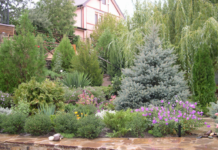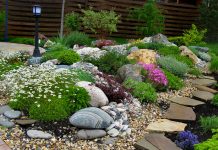Plants for an alpine hill are not as easy to pick up as they seem. Usually, these are low, small-leaved varieties with beautiful flowers or decorative leaves. You can grow valuable specimens on your own from seeds, because it is quite difficult to find them on sale.
Material Content:
How to choose plants for an alpine hill
The best choice for an alpine hill will be low-growing perennial and annual plants, the homeland of which is the highlands.

They are undemanding to soil quality, resistant to lack of moisture, wind and frost.
Such plants are suitable for an alpine hill:
- dwarf conifers;
- young-shaped fracture with pink flowers;
- silky break with white flowers;
- bellworm bellflower with miniature snow-white flowers similar to lilies of the valley;
- houston with bright blue star-shaped flowers;
- globularia, a miniature flower similar to cornflowers;
- pink alpine cloves;
- edrayantus creeping, blue;
- delosperm twisted, with bright yellow flowers;
- rotundifolia;
- Koch gentian with potion flowers;
- veronica;
- small petal blooming with small white daisies;
- alpine nibs;
- edelweiss snow;
- bell of Shamiso;
- alpine mertensia;
- levizia cotyledon, delicate flowers of cream, bright pink, white;
- primrose hill;
- Carnea the wrecker;
- Choruspore Brune;
- bell Carpathian.
When choosing plants, one should take into account where the rock garden is located - in the shade or in the sun.Shade-tolerant crops are suitable for a shaded area, sun-loving people are planted in a well-lit area.
In addition to similar requirements for growing conditions, the flowers for the alpine slide must be combined in color and height. The growth rate of the inhabitants of the rock garden should be slow, otherwise it will soon become like an ordinary flower bed.
Annual plants for rock garden
Annuals can be planted every year in a new place, changing the design of the rock garden. They decorate the hill with their bright flowering, adding variety and filling the air with aroma.
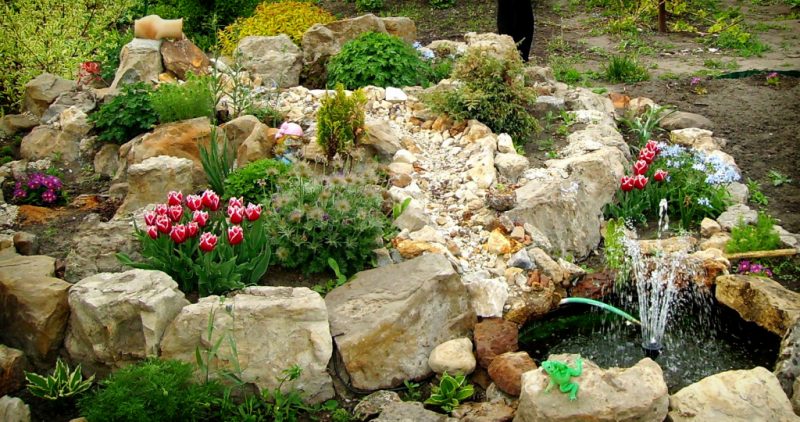
- Ageratum - flowers that look like small chrysanthemums of various colors, bloom very lushly from mid-June to frost. A heat-loving plant, therefore, is grown as an annual.
- Astra is an unpretentious flower. For alpine hills suitable undersized species. It propagates easily by self-sowing, so wilted inflorescences need to be cut.
- Bartonia is an annual with yellow flowers with a diameter of about 5 cm. It blooms from mid-summer to September. Flowers have a pleasant aroma, close when cloudy, photophilous.
- The delosperm is abundantly blooming - a ground cover with pinkish-lilac flowers-stars. A thermophilic plant that grows well in the sun, likes frequent watering.
- Chinese carnation - perennial flowers that are grown as annuals in central Russia. There are varieties with different colors of inflorescences.
Long-flowering beautiful annuals also include: snapdragon, purslane, Nolana, brachyceae, dimorphic, marigolds.
What to plant on an alpine hill of perennials
On sale you can find perennial flowers for rock gardens, most often they will have to be grown from seeds. Unique varieties and various hybrids are in the collections of breeders. Initially, the poor vegetation of the Alps has changed due to the efforts of flower growers beyond recognition.
Read also:Purslane garden

- Three-forked Azorella is a groundcover with glossy bright green leaves resembling spruce. In summer it blooms with yellow spherical inflorescences, forms a continuous dense carpet, wraps around rock gardens and repeats all the irregularities of the soil.
- Aquilegia is a beautiful flower of various colors, the corolla of which consists of two rows of petals. Shade-tolerant and unpretentious plant. For rock gardens, low-growing varieties are chosen, they are perfectly combined with other flowers in the flowerbed.
- Badan - grows well in rocky rock gardens, it has leaves with an original ornament and pink flowers. Withstands shady places without losing shape and decorativeness.
- Galanthus - primroses. Another name is snowdrops, in nature these flowers are listed in the Red Book, the only chance to admire, plant in your rock gardens.
- Globularia dwarf. It blooms in late spring or early summer with blue spherical flowers. Requires soil rich in calcium, with good drainage.
They are also popular: rocky alissum, shaved, felted warbler, phloxes, awl-shaped bryozoans, medunica, stonecrop, rejuvenation, rechka, yucca filamentous, tulips, crocuses, hyacinths.
Plants for rock garden blooming all summer
In the composition of plants on a rocky flowerbed, those that bloom all summer always look advantageous.
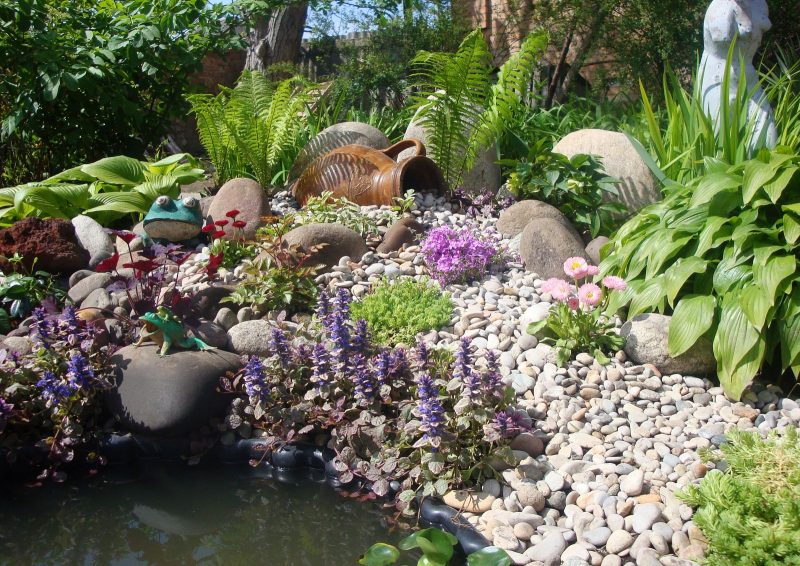
Among the annual stunted flowers, you can choose:
- nemophile;
- ageratum;
- petunia;
- Iberis annual;
- night violet;
- marigold;
- purslane.
No less beautiful are perennial flowers that bloom in early summer and bloom to the cold:
- awl-shaped phlox;
- Daisies
- begonia ever flowering.
Cloves, twisted delosperm, Veronica, Ageratum are also characterized by long flowering.
Arrangement of stones and plants
The shape of the alpine hill can be different. The placement of stones and plants on it will depend on the chosen project.
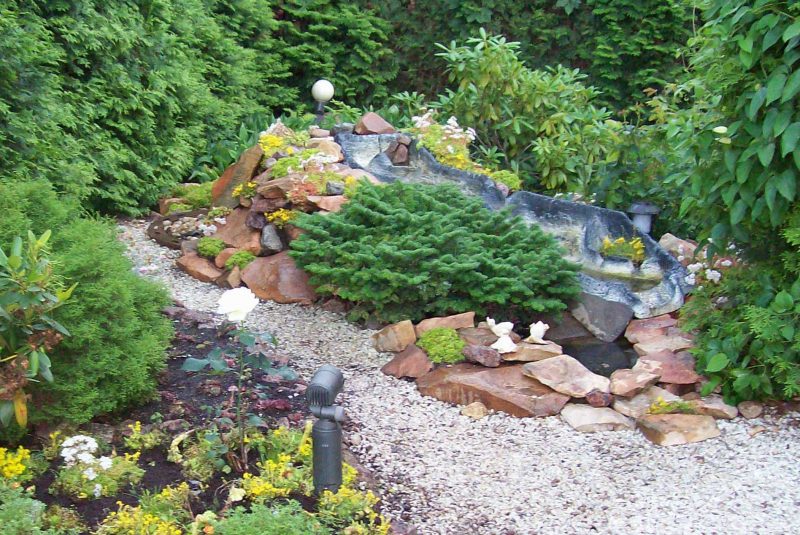
The basis of a high alpine hill is the number of storeys. The height of the upper tier is made no more than 50 cm from the soil surface.If the hill is higher, perennials can freeze in winter.
Device Stages:
- Pour a large amount of sand with gravel. If the soil is soft, gravel is added more. A high sand base is made in the form of a trapezoid.
- The stones are accented, the largest and heaviest. They should look natural, as if they always lay in the place where they were placed.
- Then the rest, smaller stones are placed. They should be combined in color, and be the same in structure.
- After the upper tier of the alpine hill, the lower one is laid, making a couple of large stones accents of the composition.
- When the flower bed is geometrically correctly built, select some sand from each tier, and add fertile soil.
- Plants are planted.
It is undesirable to fertilize plants growing on an alpine hill - they grow greatly and lose their dwarf appearance.
In order to increase soil fertility, humus is introduced during planting. Under plants with a stem root, such as levisia, they do good drainage because they tend to get wet.
The most popular rock garden device options:
- driving slope:
- rock;
- mountain valley;
- terrace;
- ravine;
- stone wall;
- Mountain Creek;
- mountain pond;
- Japanese garden.
Landscaping provides for various options for creating rock gardens. It can be a rocky flowerbed, reminiscent of a real mountain landscape or a design solution in the form of regular geometric shapes.
Rock garden in landscape design: design options
For the construction of rock gardens in the form of rocks create a steep structure, consisting mainly of boulders. Below are the largest stones, then medium in size and at the top - the smallest. For such rock gardens ferns, crassulaceae, bells, junipers and dwarf conifers are suitable.
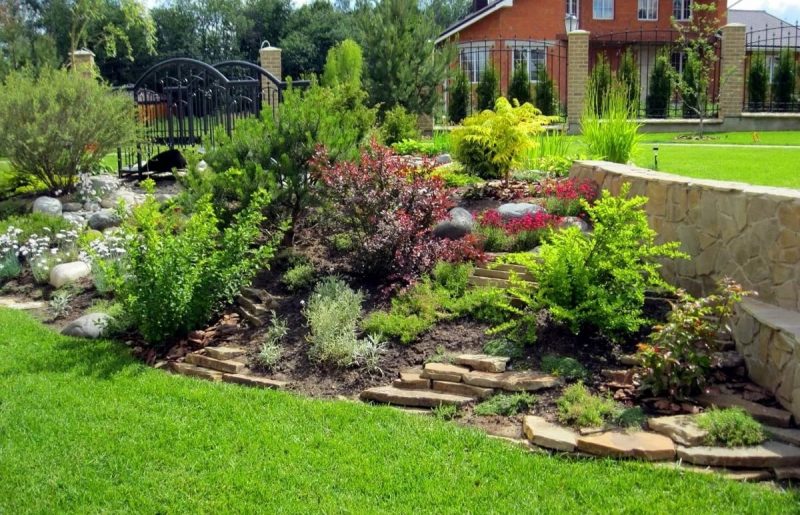
Mountain slopes are built mainly of small stones. Large boulders are used as accents and design constraints. You can plant dwarf trees and shrubs on the alpine hill with a well-developed root system to strengthen the soil. Creeping ground cover plants are also used.
The rock garden in the form of a mountain valley is made in the form of a flat structure using stones of various sizes and shapes. They are placed in a creative mess, but so that the stones are combined in color and look natural. As plants use mountain forbs, stunted conifers, bright and beautiful flowers. As the background goes groundcover.




